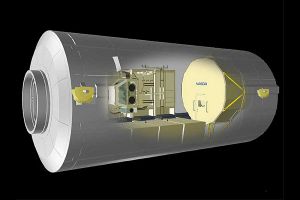
Centrifuge Accommodations Module
Encyclopedia

International Space Station
The International Space Station is a habitable, artificial satellite in low Earth orbit. The ISS follows the Salyut, Almaz, Cosmos, Skylab, and Mir space stations, as the 11th space station launched, not including the Genesis I and II prototypes...
. Although the module was planned to contain more than the a centrifuge
Centrifuge
A centrifuge is a piece of equipment, generally driven by an electric motor , that puts an object in rotation around a fixed axis, applying a force perpendicular to the axis...
, the 2.5 m (8.2 ft) centrifuge still was considered the most important capability of the module. The centrifuge would have provided controlled acceleration rates (artificial gravity
Artificial gravity
Artificial gravity is the varying of apparent gravity via artificial means, particularly in space, but also on the Earth...
) for experiments and the capability to:
- Expose a variety of biological specimens that are less than 24.5 in (0.6223 m) tall to artificial gravity levels between 0.01g and 2g.
- Simultaneously provide two different artificial gravity levels.
- Provide partial g and hyper g environment for specimens to investigate altered gravity effects and g-thresholds.
- Provide short duration and partial g and hyper g environment for specimens to investigate temporal effects of gravity exposure.
- Provide EarthEarthEarth is the third planet from the Sun, and the densest and fifth-largest of the eight planets in the Solar System. It is also the largest of the Solar System's four terrestrial planets...
simulation environment on ISS to isolate microgravity effects on specimens. - Provide Earth simulation environment on ISS to allow specimens to recover from microgravity effects.
- Provide in situIn situIn situ is a Latin phrase which translated literally as 'In position'. It is used in many different contexts.-Aerospace:In the aerospace industry, equipment on board aircraft must be tested in situ, or in place, to confirm everything functions properly as a system. Individually, each piece may...
1g controls for specimens in micro-gravity.
It was built by JAXA, but owned by NASA
NASA
The National Aeronautics and Space Administration is the agency of the United States government that is responsible for the nation's civilian space program and for aeronautics and aerospace research...
trading in a free launch of the Japanese Experiment Module
Japanese Experiment Module
The Japanese Experiment Module , also known with the nickname , is a Japanese science module for the International Space Station developed by JAXA. It is the largest single ISS module. The first two pieces of the module were launched on space shuttle missions STS-123 and STS-124...
Kibo to the Station. The CAM flight model along with the engineering model of the centrifuge rotor were manufactured. The CAM would have been attached to the Harmony module of the ISS. It was cancelled in 2005 alongside the Habitation Module
Habitation Module
thumb|right|250px|ISS Habitation moduleThe Habitation Module for the International Space Station was intended to be the Station's main living quarters designed with galley, toilet, shower, sleep stations and medical facilities. About the size of a bus, the module was canceled after its pressurized...
and the Crew Return Vehicle
Crew Return Vehicle
The Crew Return Vehicle , sometimes referred to as the Assured Crew Return Vehicle , is the proposed lifeboat or escape module for the International Space Station...
, because of ISS cost overruns and scheduling problems in Shuttle assembly flights.
It is now on display in an outdoor exhibit at the Tsukuba Space Center in Japan.
U.S. President Barack Obama
Barack Obama
Barack Hussein Obama II is the 44th and current President of the United States. He is the first African American to hold the office. Obama previously served as a United States Senator from Illinois, from January 2005 until he resigned following his victory in the 2008 presidential election.Born in...
's 2011 budget contains money for extending the ISS and this could allow procuring a new centrifuge for the International Space Station.

